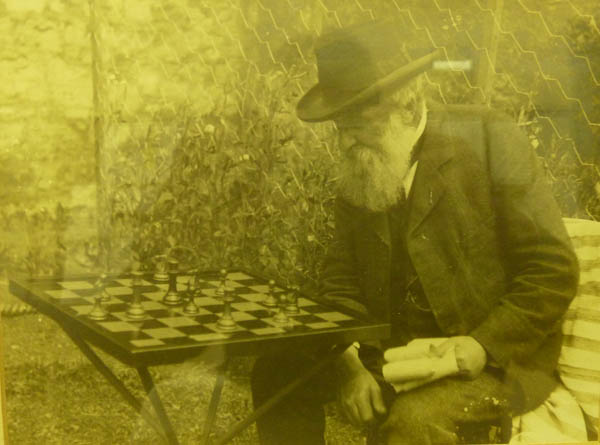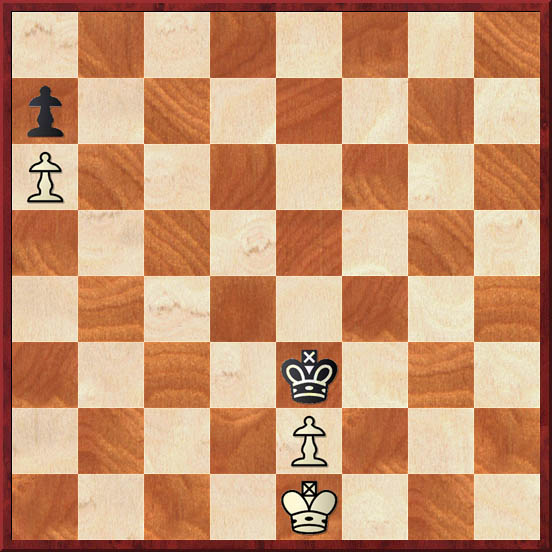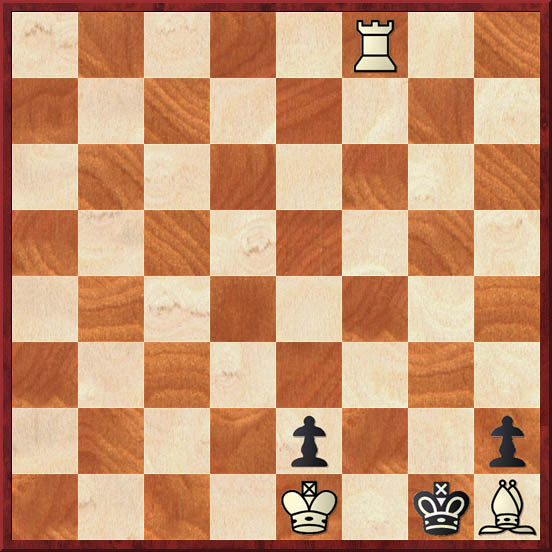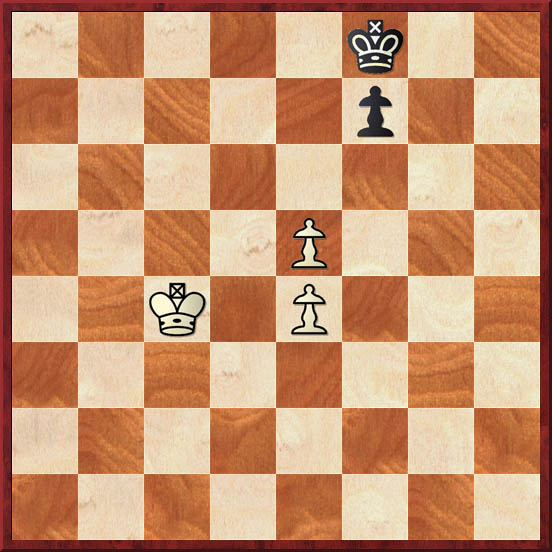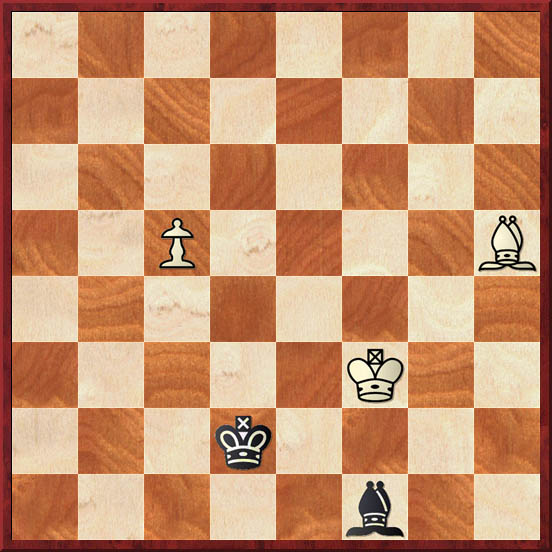 |
|
|
John Crum
19 June 1841, Pollokshaws - 27 April 1922, Edinburgh
Scottish Champion 1884
A banker, Mr Crum joined Glasgow Chess Club in 1874, and was champion of the club in 1883 and 1909, the latter event won by him when he was about 67 years of age.
He was involved with the formation of the Scottish Chess Association (SCA) in February 1884 in Glasgow, being listed as one of the directors. He would frequently be on the directorate of the association in later years.
He won the first Scottish Championship to be organised under the auspices of the SCA, which was held at the Bedford Hotel, Glasgow in July, 1884.
Championship 1884 Pts 1. John Crum 7 2. George B. Fraser 6½ 3. Sheriff Spens 6 4. David Forsyth 5 5. Daniel Y. Mills 4½ 6. G. Andrews 4½ 7. John Gilchrist 4 8. J.H.C. McLeod 3 9. John D. Chambers 2½ 10. Peter Fyfe 2 Mr Crum represented the West of Scotland in matches against the East in 1876, 1881, 1882, 1889, 1890, 1892, 1899, and 1905.
He was also a member of the Glasgow CC team in the Richardson Cup finals of 1902, 1903, 1905 and 1906 After retiring from business in Glasgow Mr Crum moved east to Inveresk, and thereafter played for Edinburgh CC, including the Richardson Cup finals of 1910 and 1912.
He also represented Scotland in in a number of matches against the Northern Counties of England, including those in 1903, 1904, 1905, 1907, and 1908.
Mr Crum participated in several congresses of the British Chess Federation, including Hastings 1904, Glasgow 1911 and Edinburgh 1920, the latter just a few years before his death.
He also played at Ostend 1906, in Amateur Tournament 'B', scoring 8/17. (His daughter, Miss A.M. Crum, travelled with him and played in a ladies' event.)
This image of John Crum, aged 69, was taken by his son, Revd. R.D. Crum, in the garden of Crum's home at Inveresk in 1911, when he was aged 69. Mr Crum resided at 10 Delta Place, Inveresk, with his daughter Agnes Crum.
John Crum was a noted composer of endgame studies, but he also had an interest in chess problems. He was responsible for the section on Problems in the Chess Player's Chronicle (new series), with Volume 1 in 1877. He also edited the regular chess column in The Glasgow Weekly Herald for a few years.
Mr Crum died in a nursing home at 41 Drummond Place, Edinburgh, on 27 April, 1922. His usual residence at that time was 4 Elcho Terrace, Portobello.
Mr Crum's daughter, Agnes M. Crum, was Scottish Ladies' Champion in 1935, 1946, 1948, and 1949.
Endgame Studies and Problems
Here are a few examples of Crum's compositions.
John Crum, 1913
White to play and win.1. Kf1! If 1. Kd1? Kd4 2. Kd2 Kc5 3. e4 Kd4 drawn.
1... Kd4 2. Kf2 Kc5 3. e4! This diverts Black from pursuing the a6 pawn. If 3...Kb6 4.e5 Kxa6 5. e6 and the pawn cannot be caught.
3...Kd4 4. Kf3 Ke5 5. Ke3 Ke6 6. Kd4 Kd6 7. e5+ Ke6 8. Ke4 Ke7 9. Kd5 Kd7 10. e6+ Ke7 11. Ke5 The tempting 11. Kc6 (going after the a-pawn) is premature, as Black takes the e-pawn without loss of time. The continuation would be 11...Kxe6 12. Kb7 Kd7 13. Kxa7 Kc7 14 Ka8 Kc8.
11... Ke8 12. Kd6 Kd8 13. Kc6 And wins, as now it will take Black two moves to capture the e-pawn. The continuation could be 13...Ke7 14. Kb7 Kxe6 15. Kxa7 Kd7 16. Kb7.Sources:
Chéron, Lehr und Handbuch der Endspiele (Vol. 2, Englehardt, 1964.
Chernev, Practical Chess Endings (Dover, 1969).■ ■ ■ ■ ■
John Crum
White to play and win.Provided by Michael McDowell, who said it appeared in Bohemia 1904, although that was likely a reprint from another source.
1. Re8 Kxh1 2. Kf2 e1=Q 3. Rxe1 mate.
■ ■ ■ ■ ■
John Crum, 1913
White to play and win.White must sacrifice at once, or he never gets another chance to do so.
1. e6! Against any other move Black's reply of 1...Ke7 assures him of a draw.
1...fxe6 Black might refuse to capture, with this result: 1...Ke7 2. exf7 Kxf7 3. Kd5 Ke7 4. Ke5 and White with the opposition wins. Or, if 1...f6 2. Kc5 Ke7 3. Kd5 Ke8 4. Kd6 Kd8 5. e7+ Ke8 6. Ke6 f5 7. Kxf5 Kxe7 8. Ke5, and again the force of the opposition wins.
2. e5! Fixes Black's pawn. Now White plays to get behind it.
2...Ke7 3. Kc5 Kd7 4. Kb6 Kd8 5. Kc6 Ke7 6. Kc7 Ke8 7. Kd6 Kf7 8. Kd7 Kf8 9. Kxe6 Ke8 10. Kf6 Kf8 11. e6 Ke8 12. e7 and White wins.Source:
Chernev, in Practical Chess Endings (Dover, 1969)■ ■ ■ ■ ■
John Crum
British Chess Magazine 1921.
White to play and win.1. c6! [1. Ke4? Bb5; 1. Be8? Kd3 2. c6 (2. Bb5+ Kd4 3. c6 Bxb5) 2. ... Kd4 3. c7 Ba6 drawn.]
1. ... Kc3 [1. ... Bh3 2. Bg4; 1. ... Be2+ 2. Kf4 Bxh5 3. c7; 1. ... Kd3 2. c7 Bh3 3. Bg4; 1. ... Ba6 2. Ke4! (2. c7? Bb7+!! 3. Kf4 Kd3 4. Ke5 Kc4 5. Bf3 Bc8 6. Kd6 Kb5) 2. ... Kc3 3. Kd5 Kb4 4. Bg4! Ka5 5. Kc5! Bb5 6. c7 Ba6 7. Kc6 and the white kings heads for b8]
2. c7! It is a draw after 2. Ke4? Kc4 3. Ke5 or (3. Bg4 Kc5; 3. c7 Bh3).
2. ... Ba6 [2. ... Bh3 3. Bg4]
3. Ke3! And not 3. Ke4? Bb7+ 4. Ke5 Kc4 5. Bf3 Bc8 6. Kd6 Kb5 drawn.
3. ... Kb4 3. ... Bc8 4. Be2 Bb7 5. Bf1 Bc8 6. Ke4 Bb7+ 7. Ke5 Kb4 8. Kd6.
4. Be2! Not 4. Kd4? Kb5 5. Be2+ Kb6 draw.
4. ... Bc8 5. Kd4 Bb7 6. Bf1 Bc8 7. Kd5 Bb7+ 8. Kd6 Ka5 If 8. ... Bc8 9. Kc6 Ka5 10. Be2 and the white king will reach b8. The text threatens ...Kb6 and a draw.
9. Kc5 Bc8 10. Kc6 Bg4 If 10. ... Kb4 11. Kb6 and again the king reaches b8.
11. Kb7! Bf5 12. Kb8 Kb6 13. Bg2 Bg4 14. Bb7 and wins.For example: 14...Bh3 15. Bc8 Bf1 (Or 15...Bg2 16. Bd7 Bb7 17. Bb5 wins.) 16. Bg4 Ba6 17. Bf3 K any 18. Be2 wins.
References:
BCM 1921, pp. 218 & 297; Chéron (as above), p. 337.■ ■ ■ ■ ■
A reference to John Crum's compositions can be found on the Arves website dedicated to endgame studies at www.arves.org
John Crum's page is at https://www.arves.org/arves/in
dex.php/en/latestnews/1571-cru m-john-1841-1922 Sources:
British Chess Magazine 1884, pp. 320-323; 1922, p. 228.
Glasgow Herald, 29 April 1922, p. 1; 3 May 1922, p. 5.
Falkirk Herald chess column of 3 May 1922.
Birth and Death certificates.
The History of Glasgow Chess Club (unpublished).
Edinburgh Chess Club, for the photograph (thanks to Raj Bhopal for providing the image).
1911 Census
Compiled by Alan McGowan
Historian/Archivist, Chess Scotlandupdated 22/6/2022
